
Sevierville is a city in and the county seat of Sevier County, Tennessee, United States, located in eastern Tennessee. The population was 17,889 at the 2020 United States Census.
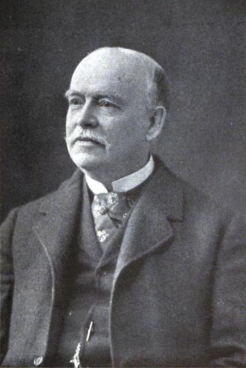
Josiah Cleaveland Cady was an American architect known for his Romanesque Revival designs. He was also a founder of the American Institute of Architects.

The Franciscan Monastery of the Holy Land in America is a Franciscan complex at 14th and Quincy Streets in the Brookland neighborhood of Northeast Washington, D.C. Located on a hill called Mount Saint Sepulcher, and anchored by the Memorial Church of the Holy Sepulcher, it includes gardens, replicas of various shrines throughout Israel, a replica of the catacombs in Rome, an archive, a library, as well as bones of Saint Benignus of Armagh, brought from the Roman catacombs and originally in the cathedral of Narni, Italy.

Romanesque Revival is a style of building employed beginning in the mid-19th century inspired by the 11th- and 12th-century Romanesque architecture. Unlike the historic Romanesque style, Romanesque Revival buildings tended to feature more simplified arches and windows than their historic counterparts.

Medieval architecture in North America is an anachronism. Some structures in North America can however be classified as medieval, either by age or origin. In rare cases these structures are seen as evidence of pre-Columbian trans-oceanic contact. Although much of this is pseudoscience, these buildings are of interest to American scholars of medieval architecture.
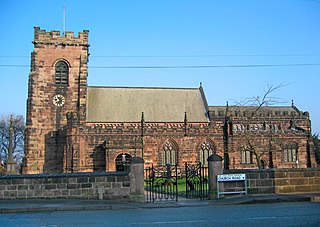
St Laurence's Church is in Church Road, Frodsham, Cheshire, England. The church stands, not in the centre of the town, but in the elevated area of Overton overlooking the town. It is recorded in the National Heritage List for England as a designated Grade I listed building. It is an active Anglican parish church in the diocese of Chester, the archdeaconry of Chester and the deanery of Frodsham.

St Mary's Church is in the small settlement of Bruera, which lies between the villages of Saighton and Aldford, in Cheshire, England. It is recorded in the National Heritage List for England as a designated Grade II* listed building. The church contains Norman elements, but it has been subjected to alterations and modifications, particularly in 1896. It is an active Anglican parish church in the diocese of Chester, the archdeaconry of Chester and the deanery of Malpas. Its benefice is combined with those of St Peter, Waverton, and St John the Baptist, Aldford.

Crouse College, also known as Crouse Memorial College and historically as John Crouse Memorial College for Women, is a building on the Syracuse University campus. It was funded by John R. Crouse, a wealthy Syracuse merchant with the White family, and designed by Archimedes Russell. It is built in the Romanesque revival—Richardsonian Romanesque style.

St Bees Priory is the parish church of St Bees, Cumbria, in England. There is evidence for a pre-Norman religious site, and on this a Benedictine priory was founded by the first Norman Lord of Egremont William Meschin, and was dedicated by Archbishop Thurstan of York, sometime between 1120 and 1135.

Stephen Carpenter Earle was an architect who designed a number of buildings in Massachusetts and Connecticut that were built in the late 19th century, with many in Worcester, Massachusetts. He trained in the office of Calvert Vaux in New York City. He worked for a time in partnership with James E. Fuller, under the firm "Earle & Fuller". In 1891, he formed a partnership with Vermont architect Clellan W. Fisher under the name "Earle & Fisher".
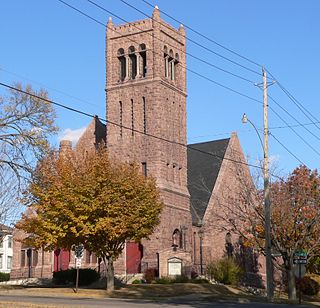
St. Thomas Episcopal Church is a parish church in the Episcopal Diocese of Iowa. The church is located in Sioux City, Iowa, United States. The church building was listed on the National Register of Historic Places in 1984.

St. Anthony's Roman Catholic Church is a historic church at 329 S. 3rd Street in Sterling, Colorado, United States. It was built in 1911 and was added to the National Register of Historic Places in 1982.
The Danforth Chapel Program was funded by the Danforth Foundation, an organization created in 1927 by William H. Danforth, founder of the Ralston Purina Company, and his wife. The Danforth Foundation focused on national education philanthropy: providing scholarships to college students, supporting projects to revitalize the city of St. Louis, and funding the Danforth Chapels. The Danforth Foundation closed in 2011 with a gift of $70M to the Donald Danforth Plant Center, a research center that focuses on solving world hunger.

Sacred Heart Church-Punahou is located at 1701 Wilder Avenue, in Honolulu, in the U.S. state of Hawaii. The church was dedicated in 1914, and its adjacent Bachelot Hall was dedicated in 1923. The property's rectory was built in 1927. It was added to the National Register of Historic Places listings on February 6, 2001.

Lindley-Johnson-Vanderhoof House is a three-story Queen Anne style brick house designed and built by William G. Fraser in 1892. The house is located in downtown Colorado Springs, Colorado and was used as a private residence from 1892 until 2000, when the Colorado College purchased the property. The house was listed on the National Register of Historic Places in 2013.
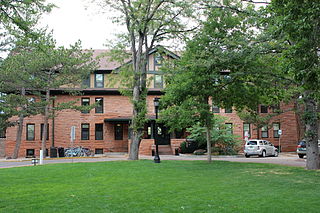
The McGregor Hall is a historic building designed by Walter F. Douglas and Thomas Duncan Hetherington and built in 1903. The building is located on the grounds of the Colorado College in Colorado Springs, Colorado. The building was the third dormitory for women on the Colorado College campus.
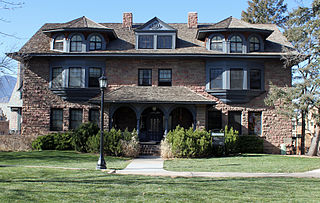
The Ticknor Hall is a dormitory for the Colorado College designed by Walter F. Douglas and finished in 1898. The dormitory was the second dormitory in the Colorado College built specifically for women. The building is located in downtown Colorado Springs, Colorado and is noted for its use of the Queen Anne architectural style.

The Harris Park School is a school building in Westminster, Colorado that was built from 1892–1899. The building was originally Romanesque Revival in architecture style, but was remodeled in the 1920s to incorporate the Craftsman style.

The Norman County Courthouse is a historic courthouse in Ada, Minnesota. It is actually the second building in Ada used by the county government. In 1883 the first offices were in a two story building on the NE corner of the block the current courthouse sits on. The county rented the space from the village of Ada for $430/yr. After the new courthouse was built, the old building was moved three blocks north.




















